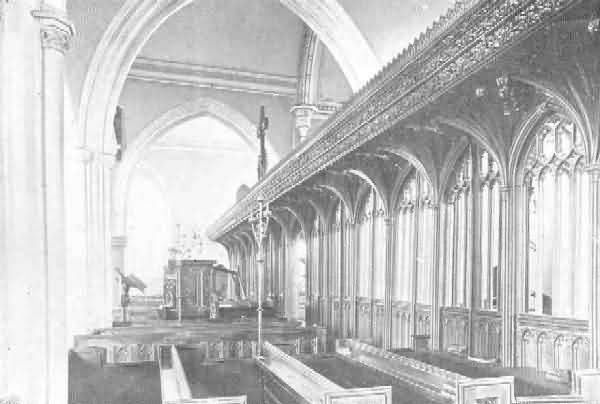
«SOME OLD DEVON CHURCHES» BY JOHN STABB; 241-252
Uffculme [241]; Ugborough [242]; Upexe [243]; Upton Helions [244]; Upton Pyne [245]; Warkleigh [246]; Washfield [247]; Welcombe [248]; Wembworthy [249]; West Alvington [250]; Whimple [251]; Whitchurch [252].
UFFCULME. St. Mary the Virgin. The church consists of chancel, nave, north and south aisles, north and south porches, and a tower with spire, containing six bells cast in 1801 from a previous peal of five, but at the rebuilding of the tower in 1849 the tenor was recast by Mears of London. The rood screen [plate 241] is the longest in Devonshire — 67 feet. The type is rare, the tracery very like that at Halberton. The portion across the south aisle is new, but has been well copied from the old.
The pulpit dates from 1719: the carved panel in front evidently does not form part of the original pulpit. There is an organ gallery at the west end of the nave, the Jacobean front and side are said to date from 1627. The font, reredos, and east window are comparatively modern, 1843. The stone altar is probably of the same date. The south aisle was built in 1847. The tower was rebuilt and the spire added in 1849. The angel with trumpet, originally on the top of the old canopy of the pulpit, has recently been restored to the church.
In the north aisle are two ancient monuments, one has three effigies, richly coloured, of a man and a woman with a youth between them, the male and female figures are holding books and the youth a scroll; the side of the tomb is panelled and has two male busts, there are Latin inscriptions on the margin, and on the upper slab four rhyming lines in English. The shields display the arms of the Walrond, Speccott, and Kelleway families.
The incumbents of Uffculme were at first rectors, they are now vicars. The list of rectors commences in 1275.
The registers date: baptisms, 1542; marriages, 1538; burials, 1538.
UGBOROUGH. St. Peter. The church consists of chancel, nave, north and south aisles, transepts, north and south porches, and embattled west tower with clock and eight bells. The nave and aisles were erected in 1323, and the church was re-consecrated in that year. The chancel was erected in 1420, and the tower in 1520. The rood screen dates from the 15th century, but the chancel portion has been cut down to the sill level; the aisle portions have had the groining removed and pieces of cornice fastened on the spandrels between the bays. The south parclose screen [plate 242a] is a fine piece of carving of later date than the rood screen, there is also a north parclose of inferior workmanship.
There is a fine series of 32 painted panels representing the Annunciation, the Adoration of the Magi, the Assumption of the Blessed Virgin, the Martyrdom of St. Sebastian, the Beheading of St. John the Baptist, and a series of female figures which have been described by the Rev. S. Baring-Gould and Mr. Bligh Bond as Sibyls [ancient Greek prophetesses]; this is, I believe, incorrect, a careful inspection will show that each of these figures carries some emblem of the Passion. Mr. Keyser gives the following list:—
NORTH.:— St. Apollonia, St. Margaret, the Annunciation, the Adoration of the Magi, the Blessed Virgin, two angels, St. John the Baptist, St. Sebastian, and a doubtful subject.
SOUTH.:— Twelve female figures bearing the emblems of the Passion (? Sybils), St. Agnes, St. Agatha, an executioner and the daughter of Herodias, part of the martyrdom of St. John the Baptist.
The martyrdom of St. Sebastian is curious [plate 242b] the archers are arrayed in trunk hose, and the painting was done about the time of Elizabeth [1558-1603].
The Norman font in this church [plate 242c] has a rather peculiar feature, the carving is only on one portion of the bowl, the remainder being plain. This is accounted for by the fact that the font, which now stands at the west end of the nave, at one time stood against a pillar, so that the carved part was protected from the hands of the despoilers who ruthlessly destroyed all they could reach: when the font was removed the plaster was cleared out of the carved portion remaining, and it is now as fresh as if it had just left the workman's hands. When one sees so much destruction of beautiful objects in our churches, one is at a loss to find a reason for it. One could understand, while not approving, the destruction of a crucifix or an image of the Blessed Virgin, from the point of view of those who committed the destruction, but in a case like this, when there are no figures or religious symbols of any kind in the carving, there is no excuse to be found for such wanton damage.
The registers date: baptisms, 1538; marriages, 1538; burials, 1542.
UPEXE. [Upexe Chapel; dedication unknown.] This is a very similar church to that of Netherexe, consisting of undivided chancel and nave, vestry, and bell turret with one bell at the west end. On the south side of the chancel is a piscina with drain. The octagonal font came from some other church. The church has been restored; some time since it had been desecrated and turned into workmen's cottages. The person who showed me the church told me she remembered seeing the piscina in the staircase of one of the cottages. Considering the history of the building much could not be expected of interest to the antiquary.
The four churches of Stoke Canon, Rewe, Netherexe and Upexe, can easily be visited in one excursion.
The registers date: n.a.
UPTON HELIONS. St. Mary. The church [plate 244a] consists of chancel, nave, south aisle, south porch, and west tower. The aisle which is shorter than the nave is separated from the chancel by two arches, in the easternmost of which is a parclose screen. There is one arch separating the aisle from the nave, resting on the support of the chancel arch.
On the north wall of the chancel is a monument [plate 244b] with a male and female figure kneeling at a prayer desk, on the front of which is carved a death's head and hour glass. The man, whose hands are clasped in prayer, kneels on a red cushion and is arrayed in long flowing black robe; he wears a ruff and the head is bare. The woman also kneels on a red cushion, the hands clasped in prayer, and wears a black gown with ruff and long veil falling over the back. A cherub's head and wings is in the splay of the arches dividing the figures; at each side are Corinthian pillars. This monument is believed to commemorate Richard Periam and Mary his wife, through whom he acquired the Upton Helion's estate; he died in 1631 and she in 1662. The roof of the aisle has bosses carved with the rose and knot. In the west wall of the aisle is an aperture which at one time opened into the south porch, but is now filled in on the west side. The nave roof has some bosses carved with human faces. The font is old with a square basin resting on a circular shaft with four smaller shafts, not separate but forming part of the main support.
There are two square-headed windows in the nave, one with three, the other with four lights. The east window of three lights is fitted with modern painted glass. At the west end of the nave there are some old carved bench-ends, one has a lion couchant on the top rail. There is a solid oak belfry screen with crenulated top.
The registers date: baptisms, 1678; marriages, 1679; burials, 1678.
UPTON PYNE. Our Lady. The church consists of chancel with priest's door, nave, north and south aisles, south porch, and west tower with six bells. It is a very fine tower [plate 245a] over the west door is a figure of Christ in benediction, on the south side one of King David, and at the angles of the summit those of the Evangelists. The north aisle is separated from the nave by three arches, and the south by three large arches and one smaller in size, beneath which now stands the pulpit. The capitals of the pillars are carved, that at the east end of the south aisle having angels holding shields with coats of arms. There is a piscina with drain on the south side of the chancel. The east wall is panelled with modern carved oak with the emblems of the Passion; the centre panel of the carved oak reredos has a painting on canvas of the Last Supper, at the sides are carved figures of the four Evangelists. The reredos is "In Memoriam Stafford Henry, Earl of Iddesleigh, C.A.B., 1887."
On the wall east of the priest's door is a tablet with coat of arms and the inscription:—
To the Memory of
Melior Hooper youngest
Daughter of Edward Pyne
of East Downe; Esq: & Relict
of Nicholas Hooper of
Fullbrook, in Braunton, Gent,
She departed this life Dec 19th
An Dom 1703 an ætatis 74.
In the north wall is a window corresponding with another on the south, but the glass has been removed, as the window now looks into the north aisle. On the wall west of the priest's door is another tablet with coat of arms, and the inscription:—
In memory of
James Gay Rector of this Parish
Son of John Gay of Frithelstock
in this County, Esq. who died ye 1st
of June in ye year of our Lord 1720
in ye 65th year of His age; & left
behind Him Elizabeth His wife
Daughter of Nicholas Hooper of
Fullbrook, in Braunton, Gent &
Melior His wife.
On the south wall is a tablet with the inscription:—
Hilda Cardew Northcote
1863 ¾ 1908
daughter of
Frederic W. Farrar
Dean of Canterbury
"A heart at leisure from itself
To soothe and sympathise!"
On the south side of the arch near the organ is a tablet with the inscription:—
To the Glory of God
X A.D. 1874
This organ isle is built
and Chancel restored
in memory of Mary
3rd Countess of Chichester
& George Carr Glyn
1st Baron Wolverton
by their children
Francis G & Alice. C. Pelham.
The east window in the north aisle was erected in memory of Henry Stafford Northcote, Esq., of Pynes, born March 18th 1792, died February 22nd 1850. On the north side of the chancel is a tablet in memory of Katherine Cecilia Rachel Northcote, the beloved child of Walter Stafford, 2nd Earl of Iddesleigh, and Elizabeth Lucy his wife, born February 23rd 1789, died October 21st 1893.
The north-east window in the north aisle is in memory of Sir Stafford Henry Northcote, Bart., of Pynes, born October 6th 1762, died March 17th 1851. The north-west window in the same aisle is in memory of Stafford Henry, 1st Earl of Iddesleigh, and is a tribute of affectionate respect from the parishioners of Upton Pyne and many friends in Exeter and Devon, born October 27th 1818, died January 12th 1887.
At the east end of the south aisle is a slab supporting a picture of the Annunciation. The inscription states:— "This slab and picture were erected on the site of an ancient altar", and on a brass plate beneath are the words:— In memory of Alice Caroline Northcote who died May 28th 1878, and was buried in Woking Cemetery; and of Mary Arabella Northcote who died May 7th 1888 and was buried in this churchyard. There is a piscina in the south wall close to this slab.
There is some good old glass in the window of this aisle representing the Agony in the Garden, the Crucifixion, and our Lord falling beneath the Cross. Beneath the window, under two arches are two old tombs, one with a recumbent figure [plate 245b], one without. The figure is a male arrayed in plate armour, the head with long curly hair, rests on a tilting helmet, the shield bears arms. The hands are clasped in prayer, the feet rest on a dog. There are five shields on the front of the tomb, three with arms and two blank. There was an inscription over the tomb, all that is now decipherable is:— Orate . p . Aia . Edmdi . It is supposed to be the monument of Edmund Larder, a former owner of Pynes, he died somewhere about 1520. The other tomb is that of later members of the same family; Humphrey Larder 1588, and Margaret his wife 1604. On the wall over the tombs is a tablet with the inscription:—
In hopes of a Blessed Resurrection
here are deposited ye sacred remains
of Lucie Stafford eldest daughter
of Sr William Courtenay of Powderham
Bart & second wife of Hugh Stafford
of Pynes Esq: who died the 10th day of
September 1693 in ye 44th of her age
And of Lucie Stafford their eldest
daughter who died ye year 1675
in the 3rd year of her age
And also of Dame Amie Slanning
Relict of Sr Nicholas Slanning of
Marstow knight of the Bath & Barot
third wife of Sir Hugh Stafford
who died the 22nd of . . . 1692
in the 49th year of her age.
The south-west window in this aisle is in memory of the Rev. Charles Stafford Northcote and his wife, it was erected by their daughter, Selina, in 1892. There is a lychgate and the remains of the old cross in the churchyard.
The registers date: baptisms, 1673; marriages, 1688; burials, 1688.
WARKLEIGH. St. John. The church, which has been restored, consists of chancel, nave, south aisle, south porch, and west tower. There is a curious opening in the pier of the easternmost arch, but architecturally the church is not of much interest. It however possesses two objects which make the church well worth a visit. In the tower arch are the remains of a fine screen with Renaissance detail; it has been compared with the screen that once enclosed a pew at the Church of Mary Tavy [Dartmoor]. After being taken down, before 1850, the neglected fragments were kept in the church, and in 1850 these fragments were made into a screen for the tower arch.
The second object of interest is probably unique, and is well known as the «Warkleigh Tabernacle» [plate 246]. The tabernacle, made of wood or stone, is the receptacle for the reservation of the Blessed Sacrament. This specimen is made of wood and had been richly coloured. Front, back and sides have a green field enclosed within a vermilion border. There is a circle in the middle of the field consisting of a jewelled ring of gold. On the door and back within the rings are Tudor roses etched in with black; the sides have stars in vermilion on a white ground. Each jewelled circle is surrounded with a wreath of red and white sprays of leaves. The corners of the box are cusped with white, and within the cusps are gilt roses. There is a jewelled gold circle on the top with an arcading of white on black and red, the whole surrounded by leaf work in a wheel. (This description of the colouring is gathered from an article by the Rev. S. Baring-Gould, in The Transactions of the Exeter Diocesan Architectural Society, Vol. 5, p. 126.)
The following description, taken from the Proceedings of the Society of Antiquaries, December 14th 1905, is on printed paper in the church:—
"J. B. P. Karslake, Esq., M.A., F.S.A., by permission of the Rev. J. J. Thorold, exhibited an ancient tabernacle which is now preserved in Warkleigh Church, Devon.
A description of this object has already been published by the Rev. S. Baring-Gould in The Transactions of the Exeter Diocesan Architectural Society for 1892, with a mechanical and somewhat rude coloured illustration. In his observations Mr. Gould has omitted to notice that the tabernacle is made up of older materials, or that the moulded wooden base is unpainted, and he says nothing as to its probable date. The tabernacle is formed of a box which must have been about 8 inches high, made of thin oak boarding, with a top and bottom of the same material.
All four sides and the top have been decorated with colour and gilding. The box was originally 5¾ inches square, but has been somewhat cut down, and differently put together again to insert it into a plain oaken block with semi-classical mouldings. The box was probably first made and decorated with colour during the third quarter of the fifteenth century, and evidently came from the same workshop as the painted housing of a St. John's head of alabaster now in the Leicester Museum, which was exhibited to the Society in 1890, and subsequently illustrated in Archæologia.
The box was probably reconstructed in its present form to serve as a temporary tabernacle for the Blessed Sacrament on the restoration of the old form of service at the Accession of Queen Mary [1553], in place of the hanging Pyx which had been appropriated to the King's use in 1552. The roughly made hinges and lock are of the same date as the conversion of the box into a tabernacle."
The registers date from 1538.
WASHFIELD. St. Mary. The church consists of chancel and nave connected with the north aisle by four arches, south porch, and embattled west tower containing five bells, dating from 1787 to 1861.
In 1624 the ancient rood screen was removed and the present one erected [plate 247a]. It was erected by Henry Sebright, and is remarkable for the detail of the coving, which is very rich. Originally the arms of James I [r. 1603-1625] were on the screen over the chancel doors [plate 247b], for some reason these removed to the tower, but the present vicar has replaced them in their original position. Over the aisle doors are the Prince of Wales' feathers marked "C.P." On the north aisle wall is a brass with kneeling effigies of Henry Worth, died August 3rd 1606, his wife and daughter with shield of arms, and at the foot is a Latin inscription. There is also an inscribed brass with a long rhyming epitaph and two shields of arms. There is also a very ancient Norman font.
The first rector was William de Berkelay, 1265.
The registers date from 1554.
WELCOMBE. St. Nectan. The church consists of chancel and nave, north and south transepts, south porch, and west tower with four bells. The reredos is plain oak, at the sides are panels with the Commandments and two paintings, one of the Good Shepherd, and the other of St. Mary Magdalene. There is the inscription:— Painted, Presented, and Dedicated to the Glory of God by the Rev. E. J. Porter Vicar of the Parish in the 83rd and 85th years of his age.
There is a chancel screen of great interest remaining in the church [plates 248a and 248b], it is probably the earliest screen to be found in the county. The square-headed lights are divided by small shafts of rude workmanship. There are two divisions with four lights in each and a central doorway, the doors are missing. The cornice has three rows of carving and is possibly of later date than the screen as there is some of the 15th century ornament which is to be found at Hartland and other places. The original lower panels have been removed and the spaces filled in with the remains of the old bench-ends. These bench-ends were poppy-heads of very original character, these heads were cut off to make the ends fit the panels of the screen. The screen has probably been moved from its original position. The space in front of the chancel is covered with gravestones dating from 1600 to 1700. The reading desk has some old carving, and the lectern and pulpit are worthy of notice. Over the transept arches are carved oak panels with representations of the vine and the fig tree. Near the churchyard is an old «Holy Well». The circular font is ancient.
The registers date: baptisms, 1777; marriages, 1757; burials, 1778.
WEMBWORTHY. St. Michael. The church has been restored and contains little of interest; it consists of chancel, nave, north aisle, porch, and west tower with three bells. Behind the pulpit is a 13th century piscina.
An old inscription is as follows:—
In memory of Mary the wife
of Arthur Bury Gent., and
daughter of John Clotworthy
of Rashleigh Esq. who departed
this life the 15th day of July
Anno Dom 1651.
There are some fine bosses to the west of the old chancel arch. On the west wall of the tower are two stones, one inscribed "I. C. 1626" and the other "T. Parish 1840".
The registers date from 1674.
WEST ALVINGTON. All Saints. The church [plate 250] is Early Perpendicular and consists of chancel, with some remains of earlier work, nave, north and south aisles, south porch, and embattled west tower containing six bells.
The rood screen was standing complete in 1869, with the unusual feature of the pulpit being placed on the loft. The Bishop of Marlborough [1827-1918], when vicar of the parish, had the screen removed, and all that is now left is the south parclose and some remains of the old screen in the north and south aisles. The character of the parclose screen is rather unusual, the tracery containing small flamboyant wheels.
The registers date from 1558.
WHIMPLE. St. Mary. The church, which consists of chancel, nave, north and south aisles, south porch, and west tower with six bells, does not call for much remark, as, with the exception of the tower, it was rebuilt in 1845.
Though the building is not of much interest, it contains, preserved in the tower, a small portion of the ancient rood screen, consisting of 8 of the painted panels on which are the following saints:— (1) a king crowned, with orb and sceptre, with a white hart chained at his feet, Henry VI [r. 1422-61 & 1470-71]; (2) female saint with scythe in right hand, head in left, St. Sidwell; (3) pilgrim with staff and wallet attended by a dog, sword on thigh, St. Roch; (4) saint holding tower in right hand and crucifix in left, St. Barbara; (5) saint bound and pierced by 17 arrows, St. Sebastian; (6) saint in bishop's dress holding an anchor, St. Clement; (7) saint carrying a lamb, St. John the Baptist; (8) female saint with pincers in her hand grasping a tooth, St. Apollonia. In the description, hung up in the church, No. 4 is given as St. Philip, and No. 7 as St. Agnes, but the tower is the emblem of St. Barbara, and No. 7 is certainly a male figure, as traces can be seen of a beard.
The registers date from 1653.
WHITCHURCH. St. Andrew. The church is Perpendicular, and consists of chancel, nave, north aisle, south transept, south porch, and embattled west tower containing six bells.
In the chancel there is an old monument to the Moringe family dated 1617, and a piscina; there is also a piscina in the transept.
When the old rood screen was removed from Moretonhampstead Church, part of it was brought here and erected in the north aisle [plate 252]. It is of good Perpendicular character, the groining is gone, but the spandrels spaces are filled with carving. The new screen in Moretonhampstead Church is said to be a faithful reproduction of this screen.
The registers date: baptisms, 1560; marriages, 1559; burials, 1562.

Uffculme: Rood Screen
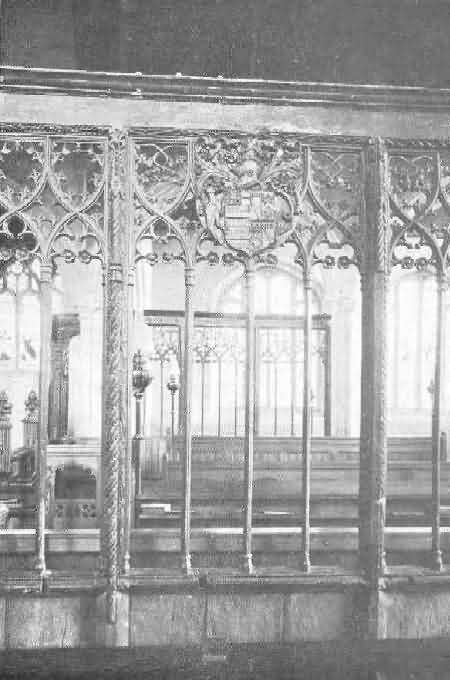
Ugborough: South Parclose Screen
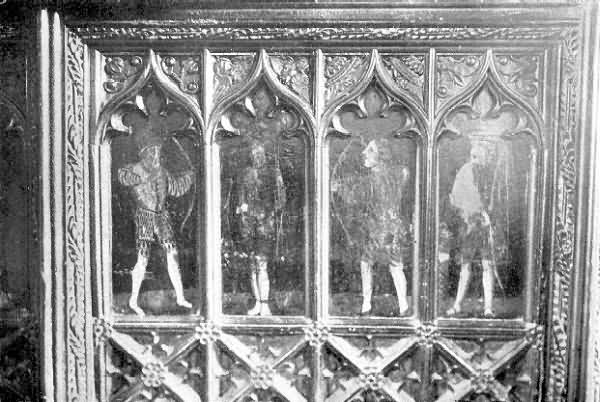
Ugborough: Paintings on Panels of Screen
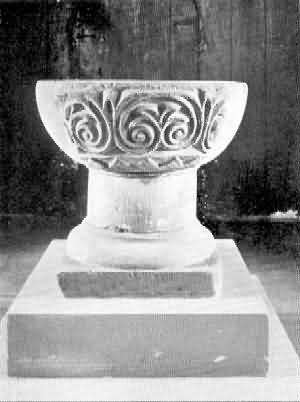
Ugborough: Font
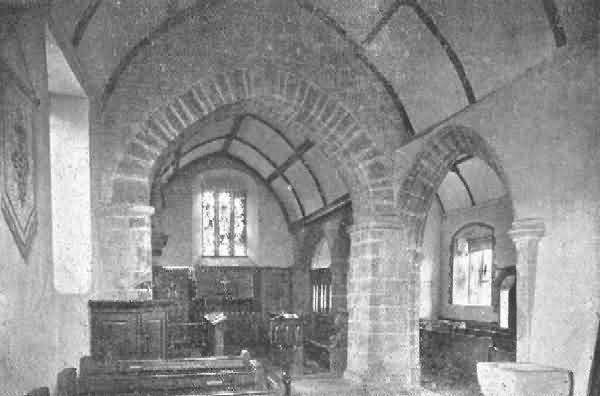
Upton Helion: Interior
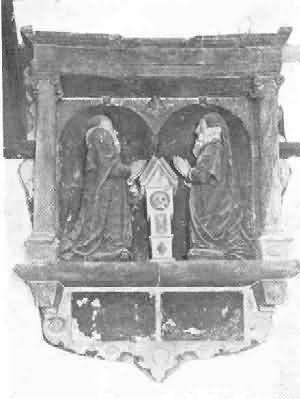
Upton Helion: Periham Monument
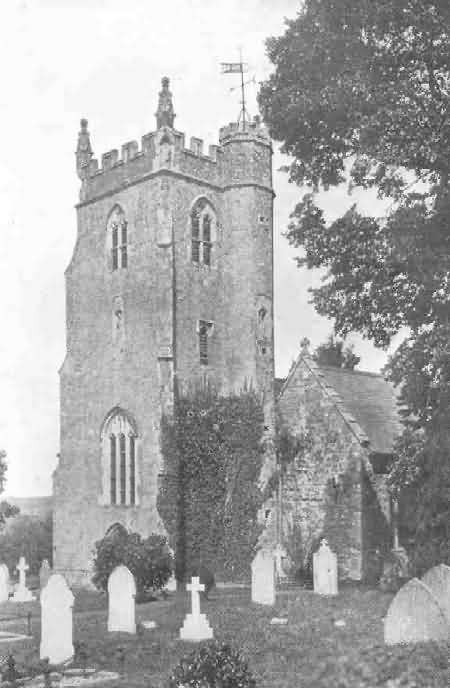
Upton Pyne: West Tower
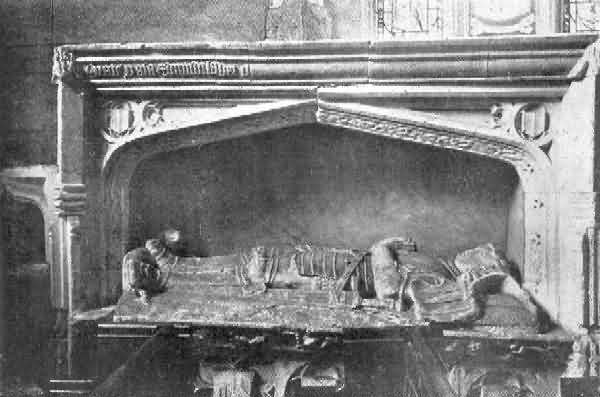
Upton Pyne: Larder Monument
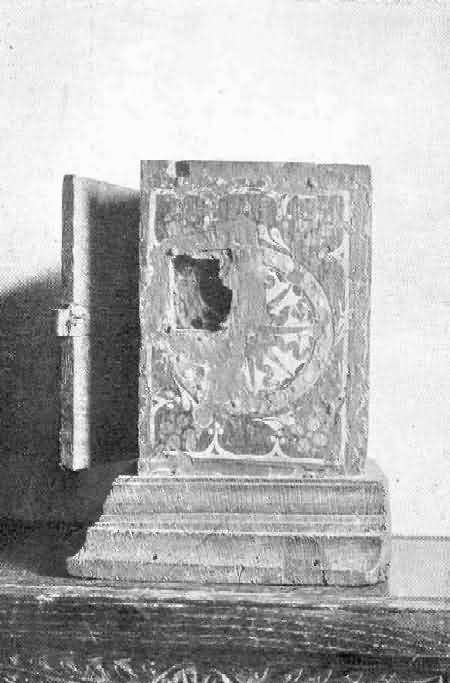
Warkleigh: Tabernacle
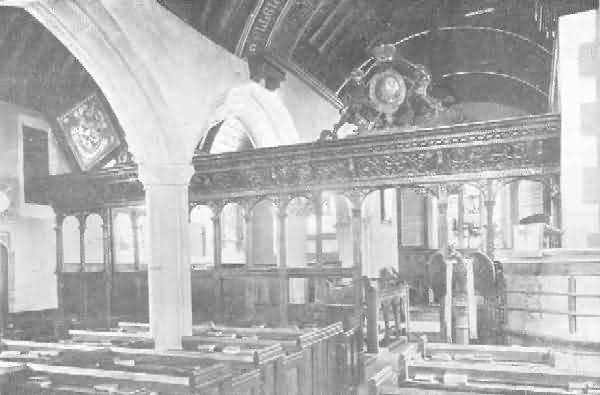
Washfield: Rood Screen
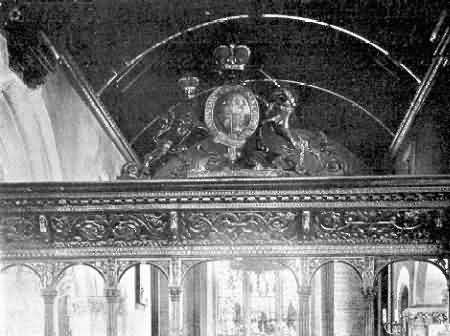
Washfield: Royal Arms on Screen
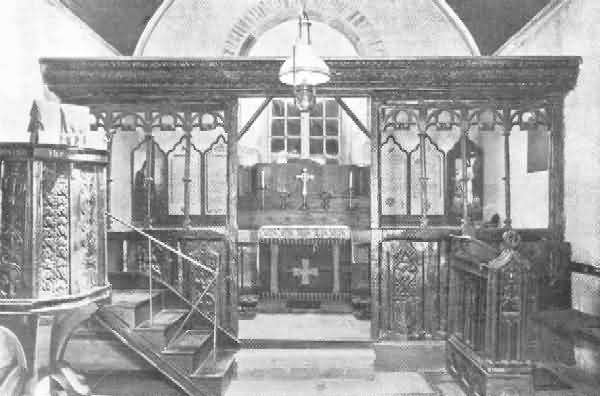
Welcombe: Rood Screen, 1
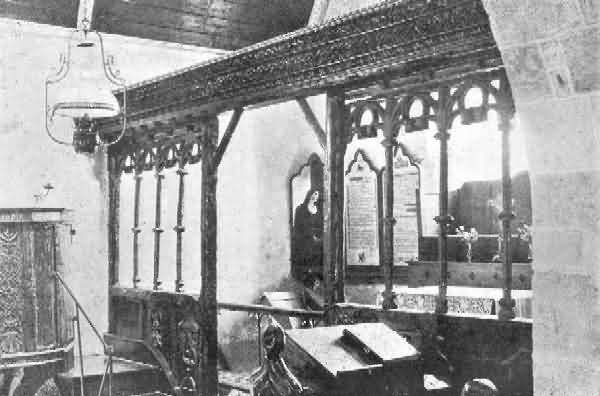
Welcombe: Rood Screen, 2
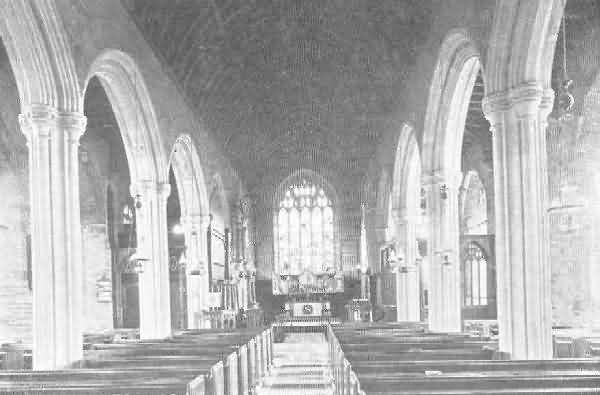
West Alvington: Interior
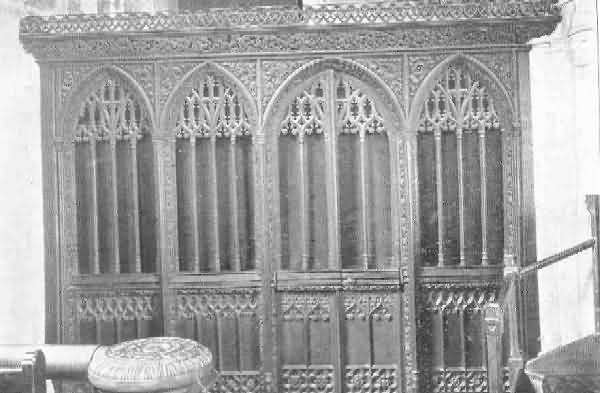
Whitchurch: North Aisle Screen
«Some Old Devon Churches»:
Index; 253-261
[Dr. R. Peters: rpeters@wissensdrang.com]